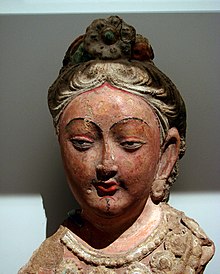



Buddhism in Central Asia mainly existed in Mahayana forms and was historically especially prevalent along the Silk Road. The history of Buddhism in Central Asia is closely related to the Silk Road transmission of Buddhism during the first millennium of the common era. It has been argued that the spread of Indian culture and religions, especially Buddhism, as far as Sogdia, corresponded to the rule of the Kidarites over the regions from Sogdia to Gandhara.[4]
Buddhism has now been largely replaced by Islam in modern Central Asia. Uzbekistan[5] and Kazakhstan[6] have the most Buddhists, largely practiced by their Koryo-saram minority, although the former has the lowest percentage of Buddhists. Due to historical Tibetan, Mongol and Manchurian influence, Kyrgyzstan[7] has the highest percentage of Buddhists in Central Asia.
- ^ von Le Coq, Albert. (1913). Chotscho: Facsimile-Wiedergaben der Wichtigeren Funde der Ersten Königlich Preussischen Expedition nach Turfan in Ost-Turkistan Archived 2016-09-15 at the Wayback Machine. Berlin: Dietrich Reimer (Ernst Vohsen), im Auftrage der Gernalverwaltung der Königlichen Museen aus Mitteln des Baessler-Institutes, Tafel 19 Archived 2016-09-15 at the Wayback Machine. (Accessed 3 September 2016).
- ^ Ethnic Sogdians have been identified as the Caucasian figures seen in the same cave temple (No. 9). See the following source: Gasparini, Mariachiara. "A Mathematic Expression of Art: Sino-Iranian and Uighur Textile Interactions and the Turfan Textile Collection in Berlin Archived 2017-05-25 at the Wayback Machine," in Rudolf G. Wagner and Monica Juneja (eds), Transcultural Studies, Ruprecht-Karls Universität Heidelberg, No 1 (2014), pp 134-163. ISSN 2191-6411. See also endnote #32 Archived 2017-05-25 at the Wayback Machine. (Accessed 3 September 2016.)
- ^ For information on the Sogdians, an Eastern Iranian people, and their inhabitation of Turfan as an ethnic minority community during the phases of Tang Chinese (7th-8th century) and Uyghur rule (9th-13th century), see Hansen, Valerie (2012), The Silk Road: A New History, Oxford University Press, p. 98, ISBN 978-0-19-993921-3.
- ^ Cribb 2010, pp. 95–96.
- ^ "The results of the national population census in 2009". Agency of Statistics of the Republic of Kazakhstan. 12 November 2010. Archived from the original on 22 July 2011. Retrieved 21 January 2010.
- ^ "Religious Intelligence - Country Profile: Kazakhstan (Republic of Kazakhstan)". 30 September 2007. Archived from the original on 30 September 2007. Retrieved 16 July 2018.
- ^ "Religious Intelligence - Country Profile: Kyrgyzstan (Kyrgyz Republic)". 6 April 2008. Archived from the original on 6 April 2008. Retrieved 16 July 2018.